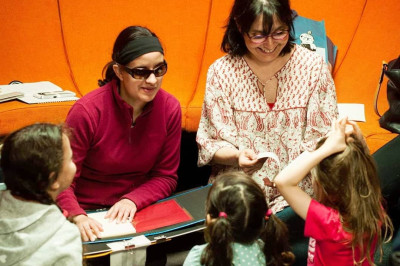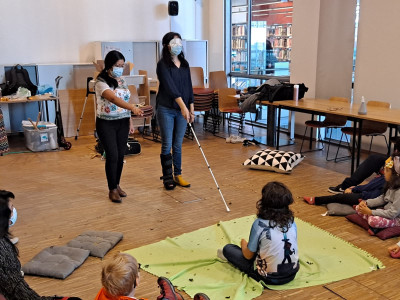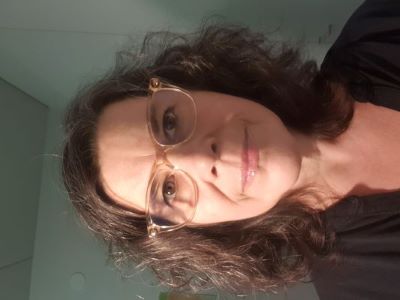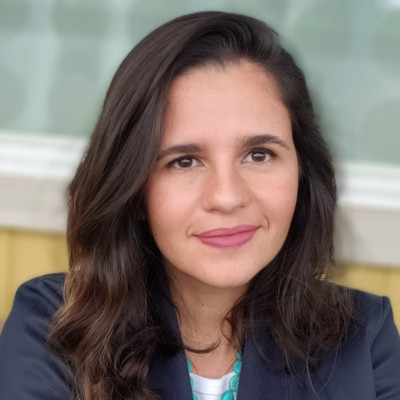Laura Gazzotti & Andréa Santos Brito: Improving diversity in children's culture: the experience of Kulttuurikeskus Ninho through Kolibrí Festivaali

Diversity at the core
The need to improve diversity and inclusion has been at the core of Kolibrí Festivaali, a children’s art festival that our association started 11 years ago. Kolibrí was actually born to fulfill the need of children and families of multicultural origins to be able to speak their heritage languages in a safe and positive atmosphere, in a time when heritage languages were viewed as a secret consigned to the home.
In all these years, our experience as members of a community that is increasingly diverse in race, age, cultural background, gender identity, disability, education level, socioeconomic status and many other factors has informed our desire to make sure that Kolibrí and all of Ninho's projects are a safe space for all.
Our history
At the beginning, fundamental questions informed what would later become Kolibrí Festivaali:
- How can WE create places for community building, supporting diversity and respect, to foster mutual understanding from early childhood?
- Could we think and work together on new models to support plurilingual, diverse and intercultural experiences in children's art and culture?
- What kind of spaces are needed to offer intercultural dialog between children not living in a diverse environment and new/second generation immigrants?
- What talents and expertise do we have in our community and how can we nurture them? How can we give these experts work opportunities and visibility?
In 2013, guided by these reflections, we won a grant from the Kone Foundation to organize an educational and artistic, intergenerational, multidisciplinary and plurilingual festival. With those funds we went out for the first time to the suburban districts of Helsinki, to Vuotalo and Malmitalo respectively, with a free, very colorful and unique program, where children were creating, playing, singing and dancing together with their parents and other adults and seniors. This grant seed funding helped us create the festival that we really wanted and allowed us to enjoy it with our children, all of us making new friends.
In 2014, we were invited to bring our proposal to the libraries of Espoo. We noticed we were growing wings.
In 2015, Kolibrí was officially born in Espoo as a festival with a biannual program, in the spring and autumn.
In 2016, Kolibrí was held in Annantalo Arts Centre for Children and Young People, celebrating Helsinki Day from a multicultural perspective. 2500 people came for this event alone! It was also the first year that we selected artists through an open call for proposals, a process that would become the standard for Kolibrí. All artists, researchers, and other professionals in the fields of education, arts and culture, of different origins and experiences, resident in Finland, can submit proposals for performances, concerts and workshops every year, in January and February. Our selection criteria are published in 5 languages and artists can apply in 3 languages. Every year, Kolibrí offers artists and culture workers the opportunity to showcase their work for multicultural audiences.
In 2017, we decided to create the multicultural association Kulttuurikeskus Ninho, to shelter this and other projects (www.ninho.fi). Having the association has helped us apply for other funds, have more transparency in our operations and document our processes to learn better.
For 2018 and 2019 we decided to concentrate our efforts to produce only the fall festival, while diversifying our offerings even more. We put renewed efforts into increasing the participation of fathers, involving other communities and working with new themes, like science communication and art/science collaborations. We also started producing other projects besides Kolibrí.
2020 and 2021 were challenging years for all, but we realized that minority audiences were even more affected by the isolation and stress brought on by the Covid-19 pandemic. In that sense, making sure Kolibrí remained on the calendar became even more important to us. 2021 saw the birth of Lukupesä, a holistic program to support immigrant parents and others in developing reading practices for heritage languages of plurilingual families. In 2021, we also provided a training session for our artists and team members on accessibility of people with disabilities for the first time.
2022 sees Kolibrí returning with no Covid restrictions and a greater emphasis on diversity and inclusion. Kolibrí 2022 offers multicultural activities for children in 22 languages: our original heritage languages and Persian, Swahili, Russian, Ukranian, German and French, among others. Our call for proposals has grown to include not only artists of an Iberoamerican background, but most, if not all, of the immigrant artist community, as well as Finnish artists providing multicultural activities. To make sure that the roster of cultural activities offered during the festival is diverse, we organized a second open call for proposals, focused on artists that are people of color or disabled, since we did not receive applications from these groups on our regular open call. We provided artists with training sessions not only on accessibility but also on anti-racism strategies. We are pioneering PICNIC, a project catering to newly-arrived immigrant families and families with new babies, that had all been specially isolated by the pandemic and needed opportunities to create their own networks.

Photo by Eduardo Acosta.
Accessibility Initiatives
The team that created Kolibrí are a group of talented, curious women and mothers from different Latin-American countries, highly educated, sometimes without an economically stable situation or the salary to match their expertise. They are constantly preoccupied by and active in the promotion of the linguistic and cultural heritage of their children. Kolibrí, to this day, is mostly based on volunteer work from the Iberoamerican community.
In a society, like Finland, where children take responsibility and manage their own autonomy from very early ages, we also wanted to reclaim a wider and more inclusive concept of family. Furthermore, we wanted to make sure Kolibrí included family members of all ages; we especially wanted to bring in the grandparents. We were mostly thinking of the Finnish grandparents of bicultural children and their presence in the lives of their grandchildren. We wanted to offer all a time and a space to learn and have fun together.
Also, many of our families include children with disabilities. We understood, on a very personal level, how important it was that these children were not only included in our cultural offerings but also saw themselves represented by the artists that were working at the festival.
From the beginning, accessibility has been a major concern. How to make sure, for instance, that grandparents with reduced mobility or visual/auditory impairments would be able to participate? How to make Kolibrí a space where children and artists with disabilities would be able to thrive and enjoy themselves without barriers? How to improve accessibility with limited resources?
We are far from achieving our goal of being 100% accessible to all people with disabilities. Still, we have made a major commitment to accessibility and have already implemented several initiatives, such as:
- Renewing our website to make it WCAG compliant;
- Creating an accessibility team and appointing an Inclusion and Accessibility officer to take part in the planning and implementation of most projects to make sure that accessibility is always taken into account;
- Making sure that we have people with disabilities represented in our team of artists, which serves a dual purpose: having our children with disabilities understand that others just like them are successful artists and helping provide visibility and employment opportunities to artists with disabilities. In 2022, we pioneered an open call for proposals focused on artists with disabilities or people of color;
- Providing training for artists and teams members on accessibility for people with disabilities, always with the presence of a disability rights activist;
- Creating a diversity statement with best practices for all our stakeholders: artists, families and volunteers/team members, to be showcased during the festival (Kolibrí 2022);
- Providing a sensory room for guests, artists and team members to rest or regulate themselves during festival days (since 2021);
- Piloting special sessions for children with disabilities (PICNIC 2022).

Inclusion as an ongoing commitment
We understand we have a long path ahead and a lot of learning and unlearning to undergo. In that sense, we continually strive to create and nurture relationships with partner institutions, researchers, activists, governmental institutions and all that can be by our side and help us grow in our mission to be truly inclusive.
We also rely strongly on the feedback we receive from all our stakeholders, never afraid to acknowledge our mistakes when they happen, and to make sure they are opportunities for growth.
But, all in all, we look especially to our community, to the needs we feel therein, to the knowledge and experiences we already partake, to make sure we don't stray from the course of becoming a safe and welcoming space for all.
Learn more
Kolibrí Festivaali 11th edition is orgaized in Helsinki, Espoo and Vantaa on 22.9-1.10.2022. Check our program and join the fun at Kolibrí Festivaali: www.kolibrifestivaali.org.
Become a member of Ninho and learn more about our other projects: ninho.fi.
Article authors:
Laura Gazzotti
 Diversity Agent
Diversity AgentCo-founder & Artistic Director of Kolibrí Festivaali
Cultural Producer at Kulttuurikeskus Ninho ry
Laura holds an MA in Arts from the University of Helsinki and a degree in Educational Sciences specialized in non-formal education from the University of Buenos Aires, Argentina. She is an expert in process-based cultural production development focused on diversity and on the children's culture sector. She builds intercultural, interdisciplinary, intergenerational and multilingual spaces and events in children´s culture, fostering diversity for children and their families, as well as for professional audiences.
Andréa Santos Brito

Inclusion and Accessibility Coordinator, Kulttuurikeskus Ninho ry
Andréa holds a Bachelor's degree in law from Universidade Federal do Ceará, in Brazil, and an MBA in general management from the Tuck School of Business at Dartmouth College, USA. She started working as a volunteer at Kolibrí Festivaali and fell in love with Ninho's mission and projects. She now leads the efforts to improve diversity and inclusion in the association, among other projects.
